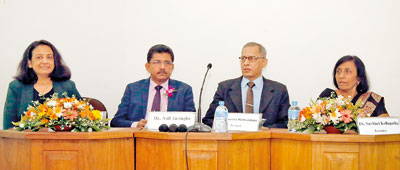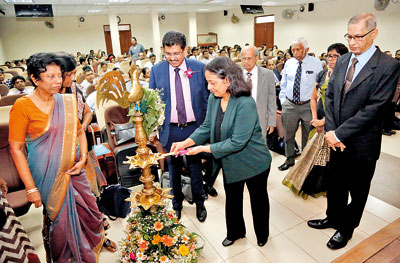News
Vaccination, the way forward to a healthy country
View(s):The country’s much-lauded immunization programme is inextricably linked to vaccines and last Sunday saw the 9th Annual Symposium of the Vaccine Forum of Sri Lanka turning the spotlight on many important issues in this arena.

At the inauguration of the 9th Vaccine Symposium of the Vaccine Forum of Sri Lanka (from left) the WHO Representative to Sri Lanka and Guest-of-Honour, Dr. Razia Pendse; the Director-General of Health Services and Chief Guest, Dr. Anil Jasinghe; the President of the Vaccine Forum, Dr. Prasanna R. Siriwardena; and the Secretary of the Vaccine Forum, Dr. Savithri Kellapatha. Pix by M.A. Pushpa Kumara
While the Chief Guest was the Director-General of Health Services, Dr. Anil Jasinghe and the Guest-of-Honour the Country Representative of the World Health Organization (WHO), Dr. Razia Pendse, the symposium was held in the New Lecture Theatre of the Colombo Medical Faculty on Kynsey Road.
Reiterating that vaccines are one of the greatest medical achievements in modern history, Dr. Jasinghe set the right note for the half-day symposium, when he said that the benefits of vaccination extend beyond the prevention of specific diseases in individuals. Vaccinations, while reducing childhood morbidity (illness) and mortality (death) also enable the country to have a healthy workforce.
With the symposium being attended by medical professionals, nurses and paramedical personnel, it was while speaking on ‘An end to human rabies deaths: Are we on the right track?’ that Consultant Virologist Dr. Dulmini Kumarasinghe of the Medical Research Institute (MRI) pointed out that rabies has been a major public health problem in Sri Lanka for a long time.
“Presently, around 20 people die due to rabies annually. The mortality is highest among the working age group in whom the nation has invested heavily. Therefore, the social and economic losses from this public health problem are substantial. The Health Ministry spends more than Rs. 300 million annually to provide rabies post-exposure therapy (PET) for dog-bite victims. Sri Lanka has set a target to eliminate dog transmitted human rabies by 2020 in keeping with the WHO target of elimination by 2030,” she said, explaining that about 99% of the human rabies cases originate from bites by rabid domestic dogs. Therefore, a reduction of human rabies depends on the prevalence of dog rabies substantially.
Dr. Kumarasinghe called for a strong multi-sectoral collaborative approach for the successful elimination of human rabies.
“Prevention of animal rabies, better public awareness and improved access to cost-effective and high-quality human rabies biological are essential for the elimination of human rabies. A reduction in any of these components will result in failure in achieving rabies elimination by 2020,” she warned.
Dealing with the ‘Diagnosis and management of vaccine induced anaphylaxis’, Professor in Microbiology, Prof. Neelika Malavige of the Sri Jayewardenepura University and Consultant Immunologist Dr. Danushka Dasanayake of the Kandy Teaching Hospital pointed out that similar to all other medical products, vaccines too can lead to hypersensitivity reactions.
According to them, rarely these may result in acute, life threatening, systemic reactions — anaphylaxis. It was found that anaphylaxis to vaccines was the third leading cause of anaphylaxis among children, in a study on patients attending an allergy clinic in Sri Lanka.
Explaining that a majority of the reported immediate hypersensitivity reactions in Sri Lanka have been to the MMR vaccine, they stated that other implicated vaccines were MR, measles, live JE vaccine, rabies PCEC vaccine, pentavalent, DT and ATD.
“Most of the children who developed vaccine-induced anaphylaxis in Sri Lanka had cows’ milk allergy or allergy to red meat such as pork or beef. In another study, it was revealed that 76.5% of the children investigated after immediate hypersensitivity reactions following vaccination were sensitized to bovine serum albumin (BSA), which is a minor protein component of cow’s milk,” they explained.
Citing the case of the deaths of two girls due to anaphylaxis following the rubella vaccine in 2008 and the temporary suspension of the rubella immunization programme that led to an increase in the incidence of congenital rubella syndrome, Prof. Malavige and Dr. Dasanayake urged the prompt diagnosis and appropriate management of anaphylaxis as the cornerstone of maintaining vaccine compliance.
“It is also imperative that immunization is carried out in a centre where resuscitation facilities are available especially in the presence of preceding hypersensitivity to cow’s milk and or pork/ beef. It is also important that all medical officers and other healthcare personnel have a sound knowledge on the recognition and prompt management of anaphylaxis to prevent fatalities,” they added.

The Guest-of-Honour Dr. Razia Pendse lights the traditional oil lamp, as Chief Guest Dr. Anil Jasinghe, Dr. Savithri Kellapatha and Dr. Omala Wimalaratne look on
After vaccine-induced anaphylaxis, Senior Consultant Respiratory Physician, Dr. Kirthi Gunasekera took up the issue of ‘Vaccination in chronic respiratory diseases’ stating that infection is a common cause of exacerbation of all forms of chronic respiratory disease, responsible for much morbidity and mortality.
As such, influenza and pneumococcal vaccination can help reduce infections and exacerbations, he said, pointing out that age-appropriate pneumococcal vaccination should be offered to all patients with chronic respiratory disease. New vaccines against Streptococcus pneumoniae offer the possibility of striking reductions in invasive disease.
Seasonal epidemics of influenza, meanwhile, caused significant rates of severe illness and death in those with underlying chronic respiratory disease, he said, adding that the annual influenza vaccine should be given to all such patients.
It was also influenza that Consultant Medical Virologist Dr. Jude Jayamaha of the MRI looked at under the theme, ‘Universal influenza vaccine: Fallacy or reality’.
Pointing out that the effectiveness of the seasonal influenza vaccine ranges between 10% and 60%, he explained that the lowest effectiveness occurs when vaccine strains are not well matched to circulating strains.
While seasonal influenza vaccines virtually provide no protection against novel pandemic strains, he said that the cornerstone of both seasonal and pandemic influenza prevention and control was strain-specific vaccination. Strains used in annual vaccine are selected twice annually following the influenza seasons in the northern and southern hemisphere. Similarly, the emergence of a novel influenza virus with pandemic potential requires the development of a strain-specific vaccine to protect humans for an epidemic that might never occur. The current strategy for seasonal influenza vaccination keeps us at least one year behind this ever-evolving virus. The strategy for pandemic influenza leads to making, testing and stockpiling vaccines that may never be used.
“To limit the public health consequences of both seasonal and pandemic influenza, vaccines that are more broadly and durably protective are needed. Advances in influenza virology, immunology, and vaccinology make the development of a ‘universal’ influenza vaccine more feasible than a decade ago. A universal influenza vaccine should be at least 75% effective against the symptomatic influenza virus infection; protect against group I and group II Influenza A viruses, with Influenza B virus being a secondary target; have durable protection that lasts at least one year and preferably through multiple seasons; and be suitable for all age groups,” added Dr. Jayamaha.
Kalutara’s Regional Epidemiologist Dr. Prasad Liyanage who spoke on ‘National Immunization Programme in primary care — Learning from history for the future’ said that the Expanded Programme of Immunization (EPI) has been implemented to prevent vaccine preventable disease and the history of immunization in the country goes back to the 19th century. Today the National Immunization Policy is a successful public health intervention with excellent performance records.
However, systematic improvement is needed on several components of the programme to maintain quality, coverage and sustainability. Immunization related data management and data entry need improvement. As a solution, the E-Immunization strategy, the Web Based Immunization Information System (WEBIIS) has been introduced. Still it is not fully operational at immunization clinic levels where data are generated, he said.
Dr. Liyanage sought better immunization-related risk communication to the public and with vaccine hesitancy being an emerging public health problem, preparation by the health sector to meet this challenge.
Meanwhile, Dr. Sumit Srivastava from Sanofi Pasteur, India, spoke on the ‘Recent advances in the Japanese Encephalitis (JE) vaccine’.

